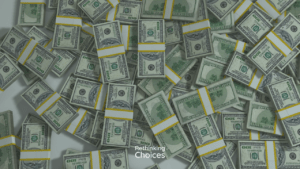Given the wobble we have witnessed in equity markets over the last couple of days, not withstanding Monday’s pathetic attempt at recovery, this piece should perhaps have been titled “A fed meeting while equities wobble (part trois)”, but having re-watched the 80’s master piece No Way Out over the week-end, I felt there was something of a connection between Kevin Costner’s character and the power-less Powell (or any other central banker of 2022). Ok, so the film is not really masterpiece a la Shawshank Redemption, The Godfather or 12 Angry Men, but it’s still an excellent 2 hours of cinematic entertainment, albeit very much entrenched in that somewhat awful 1980’s style. As the net keeps shrinking around Tom Farrell (Kevin Costner), he has fewer and fewer moves left to try to untangle himself from the hopeless situation that has been created around him. You can easily sympathise with him as the journey inevitably pushes him towards the abyss, and without revealing the end of the film (pretty cool actually) for those of you who have not seen it (really ?!?), there are a lot of similarities about the predicament of young Farrell and that of Jeremy Powell.

As the Chairman of the Federal Reserve, you are the de-facto the leader of the free world’s capitalist system, and that position carries with it a lot of responsibility. That fact becomes an obvious problem when the wagons start circling, and people like me feel it’s appropriate to take potshots at the institution with impunity, although I think I’ve shown remarkable restraint. The Fed’s authority has been severely undermined by their own actions and dare I say it – their lack of understanding of how markets actually work. To be effective in any leadership role, let alone one as important and symbolic as this one, you can never allow anyone to doubt your credentials, ability or resolve to perform in that role. The moment it becomes the accepted wisdom that you are not quite cut out for the job, you have most definitely left yourself a mountain to climb just to get back to the position you should have defended with “whatever it takes”. At the bottom of the proverbial mountain is now where the Federal Reserve has managed to position itself.

In late July, they had a golden opportunity of trying to get ahead of the game, re-assert leadership, and provide true guidance by hiking 125 bps – they didn’t, and now find themselves in the same situation two months later. It is pointless tightening policy and make it clear you will keep hiking at the next meeting (and the one after that), because if you think policy is still too lose after your hike you might as well get over with immediately by simply doing more. At least you have then boosted your credibility. To not do it in the name of the by now fabled “transparency” argument is simply moronic. The powerless Powell has so far repeated the Bernanke playbook from the run-up to GFC, a period which is best described as the biggest monetary policy fiasco in modern central bank history alongside negative interest rates, instead of actually ensuring that the Fed is up to the job. By going early, hard, and getting ahead of markets and their expectations, they would have given themselves leeway and opportunity to be the ones dictating the game. Strong leaders should be in the business of taking options, not giving them – it makes their life a lot easier.
While the strength of the greenback might lull Powell & co into thinking that the markets have attached a lot of credibility to their monetary policy approach, nothing could be further from the truth. The only reason for the dollar trading so well is that all other central banks are conducting monetary policy in an even less credible and more moronic way. Let’s take the hapless Riksbank as an example. The oldest central bank in the world tightened policy by a full percentage point yesterday, which, at first glance, comes across as forceful and credible in the fight against inflation. When you discover that short rates in Sweden are still below 2% with inflation running between 9.0% and 9.8%, depending on the measure, it comes across as significantly less so. Even a fairly basic education in mathematics will tell you that it’s very hard to get in front of markets and their expectations with that kind of policy setting. On top of 8% negative real rates, they are also still expanding their balance sheet by pursuing further quantitative easing – no wonder a US dollar is now costing the Swedes more than 11 crowns.
Markets will probably as usual greet the decision tonight with glee, bump prices for stocks a bit and cling to every dovish word found in the accompanying statement, but make no mistake about it. This is a bear market and should be traded as such. For financial assets there is No Way Out, and they will continue to fall, so use any meaningful attempt of recovery in bonds, stocks, and real estate as selling opportunities because in the grand scheme of things prices are still very elevated. With the strongest secular headwinds markets have faced for almost 50 years, equity prices simply do not bottom out with a Shiller PE of 29, dividend yields of 1.65%, and a price/book value of 3.8 – not even by a country mile. Markets have arrived here with corporate profit margins at all-time-high, not low, globalisation now moving in reverse, and most importantly, climate change really ramping up the pressure on unprepared corporates. Forget Ukraine, Covid bottle necks, and supply chain problems, the real culprit is the climate and what it will do to us going forward. Act accordingly and keep shedding risk at every decent opportunity, while simultaneously trying to buy the resilient names that still exist in the market when there are real wash-outs. It’s a tough game, but 2022 is a year where the difference in performance between truly great portfolio managers and also-rans will be quite staggering. For those of you who are hoping that hiding in bonds will insulate you from the real down draft, I have only one thing to say. Hope is not a viable investment strategy. Only day-traders can be involved in bonds here (and seemingly the Riksbank), and they are not the companions you need or want on your path to long-term prosperity. We will surely soon also start to price in some risk of sovereign defaults, but that’s a story for another day…



